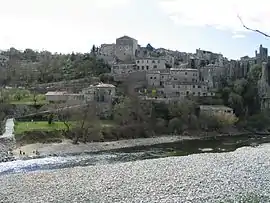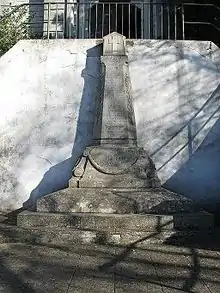Balazuc
Balazuc is a commune in the Ardèche department in the Auvergne-Rhône-Alpes region of southern France.
Balazuc | |
|---|---|
 The Ardèche River in Balazuc | |
.svg.png.webp) Coat of arms | |
Location of Balazuc 
| |
 Balazuc  Balazuc | |
| Coordinates: 44°30′34″N 4°22′23″E | |
| Country | France |
| Region | Auvergne-Rhône-Alpes |
| Department | Ardèche |
| Arrondissement | Largentière |
| Canton | Vallon-Pont-d'Arc |
| Intercommunality | Gorges de l'Ardèche |
| Government | |
| • Mayor (2020–2026) | Bernard Constant |
| Area 1 | 18.9 km2 (7.3 sq mi) |
| Population (2017-01-01)[1] | 377 |
| • Density | 20/km2 (52/sq mi) |
| Time zone | UTC+01:00 (CET) |
| • Summer (DST) | UTC+02:00 (CEST) |
| INSEE/Postal code | 07023 /07120 |
| Elevation | 113–379 m (371–1,243 ft) (avg. 159 m or 522 ft) |
| 1 French Land Register data, which excludes lakes, ponds, glaciers > 1 km2 (0.386 sq mi or 247 acres) and river estuaries. | |
The village has been labelled a "Village of Character" by the Departmental Committee of Tourism. It is a member of Les Plus Beaux Villages de France (The most beautiful villages in France) Association.
The inhabitants of the commune are known as Balazucains or Balazucaines.[2]
Geography

Balazuc is located some 16 km south of Aubenas just east of Uzer. Aubenas Aerodrome is just north of the commune. Access to the commune is by the D579 road from Vogüé in the north which passes through the commune east of the village and continues to Pradons in the south. The D294 branches off the D579 in the commune and goes west to the village. Apart from the village there are also the hamlets of Servière, Translatour, Le Retourtier, and Les Louanes in the commune. The commune is forested in the west and east with large areas of farmland in the centre.[3]
The Ardèche river flows through the commune and the village from north to south where it forms part of the southern border before continuing south to join the Rhône at Pont-Saint-Esprit. Numerous tributaries rise on both banks of the Ardèche and flow into the river including the Ruisseau de Mariou, the Ruisseau de Chadenas, the Ruisseau de Chastagnon, the Ruisseau de Tison, and the Ruisseau des Costes.[3]
Neighbouring communes and villages
History
For millennia Balazuc has been the site of a ford on the Ardèche river which was a Gallic stronghold. The name Balazuc comes from the name Baladunum of bal meaning "rock" and "dunum" or "fortified height" in Gallic
Balazuc has the remains of Neanderthal men who hunted ibex there over 50,000 years ago at the beginning of the last ice age.[4] Farmers arrived in the Neolithic period around 3000 BC. to raise goats and sheep, cultivate the bottom of the depressions, and place their dead in mass graves in stone coffins.
In the Late Bronze Age, around 750 BC., the ford below the village was used. The Gauls, for whom there is no trace, gave it its name: Baladunum. The Gallo-Romans cultivated the Plain des Salles where the great Roman road passed between the Rhône and Nîmes. An early Christian sarcophagus has been found whose high reliefs include biblical scenes (a facsimile is displayed in the town hall). In the Middle Ages the village had a church and a castle from the 11th to 13th centuries in an enclosure which dates them. The castle was originally built in the 12th century and greatly enlarged in the 13th century with a square keep. The ramparts, keep, noble houses, and fortified houses are well preserved.
The village underwent an evolution of houses across the centuries but retained its originality and the medieval character of the village with its narrow streets and its "callades".
Pons de Balazuc,[5] the son of Gérard de Balazuc, was one of the first known lords. He went on the first crusade and was killed just before the capture of Jerusalem in 1099 at the Siege of Arqa (at the archaeological site of Tel Arqa) near Tripoli (now in Lebanon).
Heraldry
.svg.png.webp) Arms of Balazuc |
Blazon: Paly of six pieces Argent and Sable, in chief Gules charged with three mullets of Or. |
Administration
| From | To | Name | Party | Position |
|---|---|---|---|---|
| 1971 | 1977 | Pierre Berre | ||
| 1977 | 1995 | Aimé Mouraret | ||
| 1995 | 2001 | Guy Boyer | ||
| 2001 | 2012 | Josiane Delsart | ||
| 2012 | 2020 | Bernard Constant |
Demography
In 2017 the commune had 377 inhabitants.
|
| ||||||||||||||||||||||||||||||||||||||||||||||||||||||||||||||||||||||||||||||||||||||||||||||||||||||||||||||||||
| Source: EHESS[7] and INSEE[8] | |||||||||||||||||||||||||||||||||||||||||||||||||||||||||||||||||||||||||||||||||||||||||||||||||||||||||||||||||||

Culture and heritage

Civil heritage
- A Chateau
 is registered as an historical monument.[9]
is registered as an historical monument.[9] - The picturesque Medieval Village from the 11th and 13th centuries
- A copy of the Balazuc sarcophagus, an early Christian sarcophagus from the end of the 4th or early 5th century found in the hamlet of Salles, visible under the Town Hall
- A Fortified House from the 13th century
- The Viel Audon village cooperative
Religious heritage
- The Romanesque Church of Saint Madeleine (11th century).
 is registered as an historical monument.[10] The windows of the Church are by the painter Jacques Yankel. The Church contains many items that are registered as historical objects:
is registered as an historical monument.[10] The windows of the Church are by the painter Jacques Yankel. The Church contains many items that are registered as historical objects:
- 2 Processional Crosses (19th century)
 [11]
[11] - A Statue: Virgin Mary (19th century)
 [12]
[12] - A Painting: Crucifixion (19th century)
 [13]
[13] - The Dome of an old Tabernacle in the gallery (18th century)
 [14]
[14] - A Statue: Virgin and child (19th century)
 [15]
[15] - A Painting: Rosary (19th century)
 [16]
[16] - A Statue: Virgin and child
 [17]
[17]
- 2 Processional Crosses (19th century)
- A Funeral chapel in ruins from the 13th century
- The Church of Saint Mary Magdelene from the late 19th century
Environmental heritage
- The Barasses climbing site
- The Ardèche Valley and the Gras de Chauzon are classified as a Zone naturelle d'intérêt écologique, faunistique et floristique (Natural area of ecological interest for flora and fauna).
- The middle Ardèche Valley and its tributaries are classified as a Natura 2000 site of Community importance
Cultural events
The Roche-Haute Association since 1982 has organised concerts and exhibitions of paintings in the Romanesque church including paintings by: Guillaume Beaugé, Jacques Dromart, and Erik Levesque.
Balazuc Picture Gallery
 Church of Saint Marie-Madeleine
Church of Saint Marie-Madeleine The Church rear
The Church rear The new Church
The new Church The new Church interior
The new Church interior The bridge on the Ardèche
The bridge on the Ardèche The Summer Tower and the Queen Jeanne Tower
The Summer Tower and the Queen Jeanne Tower The Queen Jeanne Tower
The Queen Jeanne Tower A street in the old village
A street in the old village A street in the old village
A street in the old village
Notable people linked to the commune
- Guilhem de Balaun, Castellan of Balazuc and Occitan troubadour in the 13th century.
- John M. Merriman, Professor of French History and Geography at Yale University (USA), has written a book on the History of Balazuc: The Stones of Balazuc (Norton Press).
- Aimé Bocquet, pre-historian, in 2011 published a synthetic history of the village since ancient times focusing on life in the Middle Ages based on a tax document dated 1464: Balazuc, medieval village of Vivarais (Éditions Plumes d'Ardèche) (in French).
See also
External links
- Balazuc on Lion1906
- Balazuc on Géoportail, National Geographic Institute (IGN) website (in French)
- Balazuc on the 1750 Cassini Map
References
- "Populations légales 2017". INSEE. Retrieved 6 January 2020.
- Inhabitants of Ardèche (in French)
- Google Maps
- Balazuc, one of the most beautiful villages in France, Aimé Bocquet
- Ponce de Balazuc, Father Fillet, imprimerie centrale du Vivarais, 1895 (in French)
- List of Mayors of France (in French)
- Des villages de Cassini aux communes d'aujourd'hui: Commune data sheet Balazuc, EHESS. (in French)
- Population en historique depuis 1968, INSEE
- Ministry of Culture, Mérimée IA00116641 Chateau (in French)
- Ministry of Culture, Mérimée PA00116642 Church of Saint Madeleine (in French)
- Ministry of Culture, Palissy PM07000513 PM07000512 Processional Crosses(in French)
- Ministry of Culture, Palissy PM07000511 Statue: Virgin Mary (in French)
- Ministry of Culture, Palissy PM07000510 Painting: Crucifixion (in French)
- Ministry of Culture, Palissy PM07000509 Dome of an old Tabernacle (in French)
- Ministry of Culture, Palissy PM07000508 Statue: Virgin and child (in French)
- Ministry of Culture, Palissy PM07000507 Painting: Rosary (in French)
- Ministry of Culture, Palissy PM07000506 Statue: Virgin and child (in French)
| Wikimedia Commons has media related to Balazuc. |